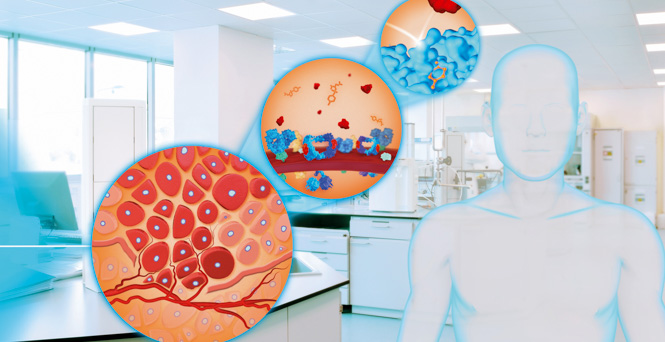URL: https://v1.desy.de/site_www-desy/content/petra4/research_topics/health/index_eng.html
Breadcrumb Navigation
Understanding the interaction of molecules, cells and tissues

For targeted cancer therapies, docking sites are an important target because these receptors control mechanisms such as blood vessel formation in the tumor. If suitable drugs (orange) prevent certain docking sites (blue) from being activated by growth factors (red), this inhibits tumor growth. PETRA IV can visualize the process from molecular drug docking to what happens across cells.
Innovative medicine
Closely linked to health research
The research carried out at DESY is extremely diverse. The scientists who work here are looking for the tiniest building blocks of matter that make up our world, developing innovative high-tech materials and searching for new mechanisms of action for future medications. As one of Germany’s largest research centres, DESY carries out fundamental research that creates new knowledge and new conceptual approaches. This research is the basis on which the challenges of the future can be mastered: issues such as energy supply, climate protection and healthcare require long-term thinking, sustainable solutions and new technologies. Research at DESY focuses on four areas:
»Medicine continues to face numerous challenges in the 21st century. Cancer, diabetes, dementia or cardiovascular diseases are on the rise. New pathogens threaten people's health, and the spread of infectious diseases or multi-resistant germs requires new tailored active agents and molecular biological therapies. With unique insights into molecules, cells and tissues, PETRA IV opens up completely new possibilities for health research.«
Precise therapy against cancer
A key mechanism of tumor growth is angiogenesis: the formation of micro blood vessels. These supply the tumor with oxygen and nutrients. If it is possible to intervene in this process, the tumor can no longer grow or can grow less quickly. Basic research is still in its infancy: How exactly are blood vessels constructed and how do they grow? How can active substances be placed with pinpoint accuracy? What side effects do they have? PETRA IV studies can provide answers to these and other questions.
Interdisciplinary strong in health research
Even beyond cancer research, the new imaging possibilities at PETRA IV represent a milestone for health research. The X-ray examinations help to better understand neurodegenerative diseases such as Alzheimer's or bone diseases such as osteoporosis. For example, PETRA IV can map how individual neurons communicate in the brain and make defects in bones visible on the nanoscale.
An image of the cell in its natural environment
- In experiments with X-ray light at PETRA IV, the cell is analyzed as part of its natural environment.
- At PETRA IV, large samples in which biological processes are relevant can be studied as standard. Images that were previously only possible with extraordinary experimental effort and significantly less detail will become routine.
- For the comprehensive analysis of biological samples, instruments such as cryo-electron microscopes and the ultrafast X-ray laser European XFEL can be used on campus complementary to PETRA IV.


